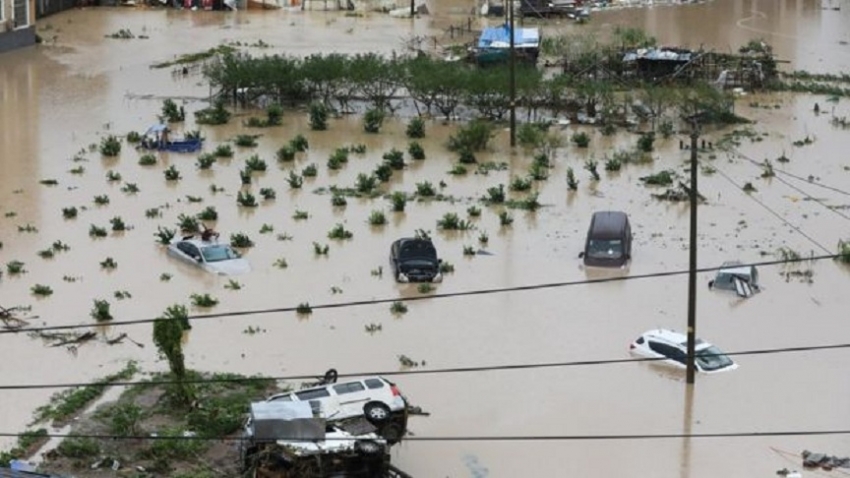Lekima made landfall in the early hours of Saturday in Wenling, between Taiwan and China's financial capital Shanghai, packing strong winds and heavy rain.It was moving further north up the east coast on Sunday.Most of the deaths were in the city of Wenzhou where torrential downpours caused a landslide, state media said.
The landslide occurred after a barrier lake - or natural dam - formed, pooling water from the heavy rains before collapsing.Emergency crews battled to save stranded motorists from floods and searched for survivors in the rubble of damaged buildings.
Lekima has now passed over Shanghai and is expected to hit Shandong province later on Sunday.
Cars were left partially submerged in water in Wenzhou, Zhejiang province
Shanghai evacuated some 250,000 residents.More than 3,200 flights have been cancelled due to the typhoon with Shanghai, Beijing and other cities grounding planes.
Lekima is the ninth typhoon to hit China so far this year.Weather experts quoted by Xinhua news agency said it was among the top three strongest typhoons to have ever hit Zhejiang.It was initially given China's highest level of weather warning but was later downgraded to an "orange" level.Chinese weather forecasters said the storm, which had winds of 187km/h (116mph) when it made landfall, was moving north at 15km/h.
It earlier passed Taiwan, skirting its northern tip and causing a handful of injuries and some property damage.Lekima is one of two typhoons in the western Pacific at the moment.Further east, Typhoon Krosa is spreading heavy rain across the Northern Mariana Islands and Guam. It is moving north-west and could strike Japan some time next week, forecasters said.
Hurricanes and typhoons: How to survive a major storm
On opposite sides of the world, two major storms have forced people to flee their homes and are threatening to bulldoze infrastructure and buildings.In the US, officials warn that Hurricane Florence could cause "catastrophic" flooding which could kill "a lot of people" on the country's east coast.Meanwhile, a super typhoon has arrived in the Philippines and officials say more than five million people are in its path.
The looming disasters have prompted people to prepare their homes and stock up on supplies. But what is best practice? And how can you cope once a storm has hit?Here's what officials from both countries advise...
Housing
Images of people in the US boarding up the windows of their homes and businesses are commonplace when a hurricane is nearing land. But the government's advice, posted as part of the Ready Campaign, suggests that installing permanent storm shutters in advance is the safest option. If there is no time then it advises using "exterior grade or marine plywood" to board up your windows.
"There could be a lot of debris and loose items that become projectiles," James Joseph, from the Federal Emergency Management Agency (FEMA), tells the BBC. "The heavy winds will pick items up and they could smash through windows."
When a hurricane hits, then, it's best to shelter in a windowless room or hallway on the lowest floor of a building, providing that it's not at risk of flooding."If you get trapped in a flooded building, go to the highest floor but do NOT enter a closed attic," FEMA tweeted as Hurricane Florence approached landfall on Friday.In the Philippines, people in the path of Super Typhoon Mangkhut have been readying their homes by tying down their roofs with rope.Residents of vulnerable makeshift houses near the coast have had to improvise ways to secure their properties. Some have weighed down their roofs with tyres and shuttered their windows with any materials they can find."Examine your house and repair its unstable parts," advice from the Philippine Red Cross (PRC) says. It suggests securing pets in a safe place, storing your most important belongings on high ground, and turning off the main power switch.
Once a home is secured and prepared then people may either bed down to ride the storm out, or - if they're subject to an evacuation warning - move to a safer place."The biggest mistake people make is not heeding the warnings," Mr Joseph says. "They find themselves in very dangerous situations."More than a million people have been ordered to leave the coasts of the Carolinas and Virginia, with more than 20,000 taking refuge in emergency shelters.
Similarly in the Philippines, thousands of people are being evacuated from their homes and placed in temporary shelters.But what should people bring with them when leaving?According to official advice in the US, an emergency preparedness kit should include:
Three days' worth of food and water
Medicine
A torch
Batteries
Money
First aid kit
The PRC advice adds that candles and battery-powered radios should be easily accessible.
Aftermath
Once the worst of a storm has subsided and people are able to return home, there are still a number of dangers, officials say.
"Avoid wading in floodwater, which can contain dangerous debris. Underground or downed power lines can also electrically charge the water," the Ready Campaign warns.It also advises wearing protective clothing when cleaning up, and working with someone else."You don't want to get injured in a situation when you're alone," Mr Joseph says. "Cell phone services might not be working so you definitely want to at least be in a pair so if anything occurs the other person can seek assistance for you."He adds that people should not enter their home if the area has been closed off by the police or fire department."First responders need to ensure that the power has been turned off and any open gas lines have been turned off," he says. "We don't want there to be another emergency or disaster within the already existing disaster."
Officials say floodwater can pose a number of different dangers
In the Philippines there are some more unique risks. "Beware of poisonous animals like snakes that may have entered your house," safety tips issued by the National Police in 2014 say.The PRC also says to avoid letting floodwater accumulate in cans or pots to avoid "creating a favourable condition for mosquito breeding." It adds that any damaged electrical cables and posts should be reported to the authorities.




















